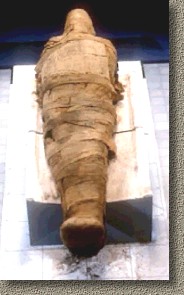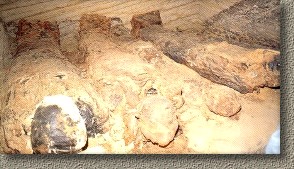
Although many long-ago cultures prepared their dead as mummies, the most well-known examples are the mummies prepared by the ancient Egyptians. In fact, they are believed to be the first people, beginning over 6000 years ago, to practice embalming, in which a dead body is artificially preserved to retard the decaying process. The Egyptians believed that it was necessary to preserve a body in order to allow the soul to survive.
Egyptian embalming methods involved the removal of the brain and organs from the body. Next the body was immersed in carbonate of soda, and the cavities were filled with a mixture of herbs, salt, and other substances. Finally, the body was wound with cloths saturated with similar materials.
The mummification process took seventy days. Special priests did the embalming; they must have had a detailed knowledge of human anatomy.
The brain was removed by carefully inserting special hooked instruments up through the nostrils, in order to pull out bits of brain tissue. It was a delicate operation, one which could easily disfigure the face if they weren't careful.
The embalmers then removed the organs through a cut made on the side of the abdomen. They left only the heart in place, believing it to be the center of a person's being and intelligence. Next, moisture was removed from the remaining tissue by packing the insides with a type of salt.
After this, the mummy was made even more life-like by filling sunken areas of the body with linen and other materials. False eyes were added, and often the body was painted. Jewelry was added for adornment.
|

Ancient Egyptian embalming methods included immersing the dead body in carbonate of soda, and injecting its cavities with herbal substances, before wrapping the corpse with cloths, creating a mummy.
|

Next came the wrapping of the mummy. Every part of the body was wrapped individually. For instance, the hands, head, arms, feet, legs were all wrapped separately from the rest of the body. Each mummy needed hundreds of yards of linen, along with warm resin to seal the layers of fabric.
  The Egyptians were very good at embalming. The feet of mummies, when unwrapped after as much as 3000 years, are often still soft and elastic. 'Historians estimate that by AD 700, when the practice had died out, the Egyptians had embalmed approximately 730 million bodies'. (Encarta 1998) The Egyptians were very good at embalming. The feet of mummies, when unwrapped after as much as 3000 years, are often still soft and elastic. 'Historians estimate that by AD 700, when the practice had died out, the Egyptians had embalmed approximately 730 million bodies'. (Encarta 1998)
Although many mummies were destroyed by the tropical heat of northern Africa, or were lost when tombs were looted, archaeologists believe that millions are still preserved in undiscovered tombs and burial places. Many are probably in their original coffins, which were often, if the deceased was rich, decorated to resemble the person who had died.
Resources
|


 The Egyptians were very good at embalming. The feet of mummies, when unwrapped after as much as 3000 years, are often still soft and elastic. 'Historians estimate that by AD 700, when the practice had died out, the Egyptians had embalmed approximately 730 million bodies'. (Encarta 1998)
The Egyptians were very good at embalming. The feet of mummies, when unwrapped after as much as 3000 years, are often still soft and elastic. 'Historians estimate that by AD 700, when the practice had died out, the Egyptians had embalmed approximately 730 million bodies'. (Encarta 1998)